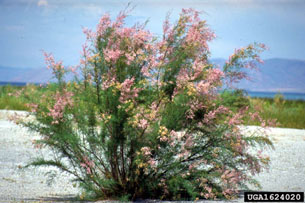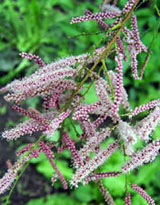Salt cedar
When salt cedar is present, it can inhibit the growth of natural vegetation and seriously alter water flow and availability. Fortunately, salt cedar hasn’t invaded Calgary – yet.
What is salt cedar?
Plant Type: woody shrub, bushy or tree-like
Size: 1-3 metres
Leaves: tiny (1mm) overlapping scales
Flowers: 5 petaled tiny pink flowers in .5 cm spikes on branch tips, blooms in early spring
Other: reddish-brown bark

Tens of thousands of salt cedar seeds are produced annually, spread by wind and water. Salt cedar ingests and excretes salt, inhibiting the growth of other plants in the process. This invasive plant re-sprouts easily from root and stem parts, making it hard to eliminate. When salt cedar spreads, it aggressively invades natural areas and river banks. Salt Cedar has not yet invaded Alberta but it dominates riverways in Montana and threatens to spread to Calgary with each season.
Salt Cedar is also known as tamarisk, pink cascade yamarisk, summer glow tamarisk, rosea tamarisk, smallflower tamarisk, Chinese tamarisk, tamarix spp. (T. ramosissima, T. chinensis, T. parviflora.)
What can I do to stop the spread of salt cedar?
- Avoid planting tamarisk/salt cedar species and Tamarix varieties.
- Mature plants will require digging to remove as much plant and root material as possible.
- Shrubs can be cut down and either treated with a recommended systemic herbicide or a non-chemical alternative to the cut stump (if you opt to apply a chemical control, always follow the label rates and use only what is recommended to treat the specific weed of concern.)
Alternatives to salt cedar

Consider some of these shrubs as alternative landscapes plants:
- Joe Pye weed 'purple bush' (Eupatorium maculatum 'purple bush')
- Queen of the Prairies (Filapendula rubra 'venustra')
- Donald Wyman lilac (non-suckering Syringa spp.)
- Witchita blue juniper (Juniperus scopulorum 'Witchita blue')
- Tolleson's blue weeping juniper (Juniperus scopulorum 'Tolleson's Blue')
- Hardhack/steeple bush (Juniperus douglasii)
More information
- University of Nevada, Reno. Cooperative Extension - Wanted - Dead Not Alive
- Learn more about The City initiatives to prevent invasive plant infestations.

